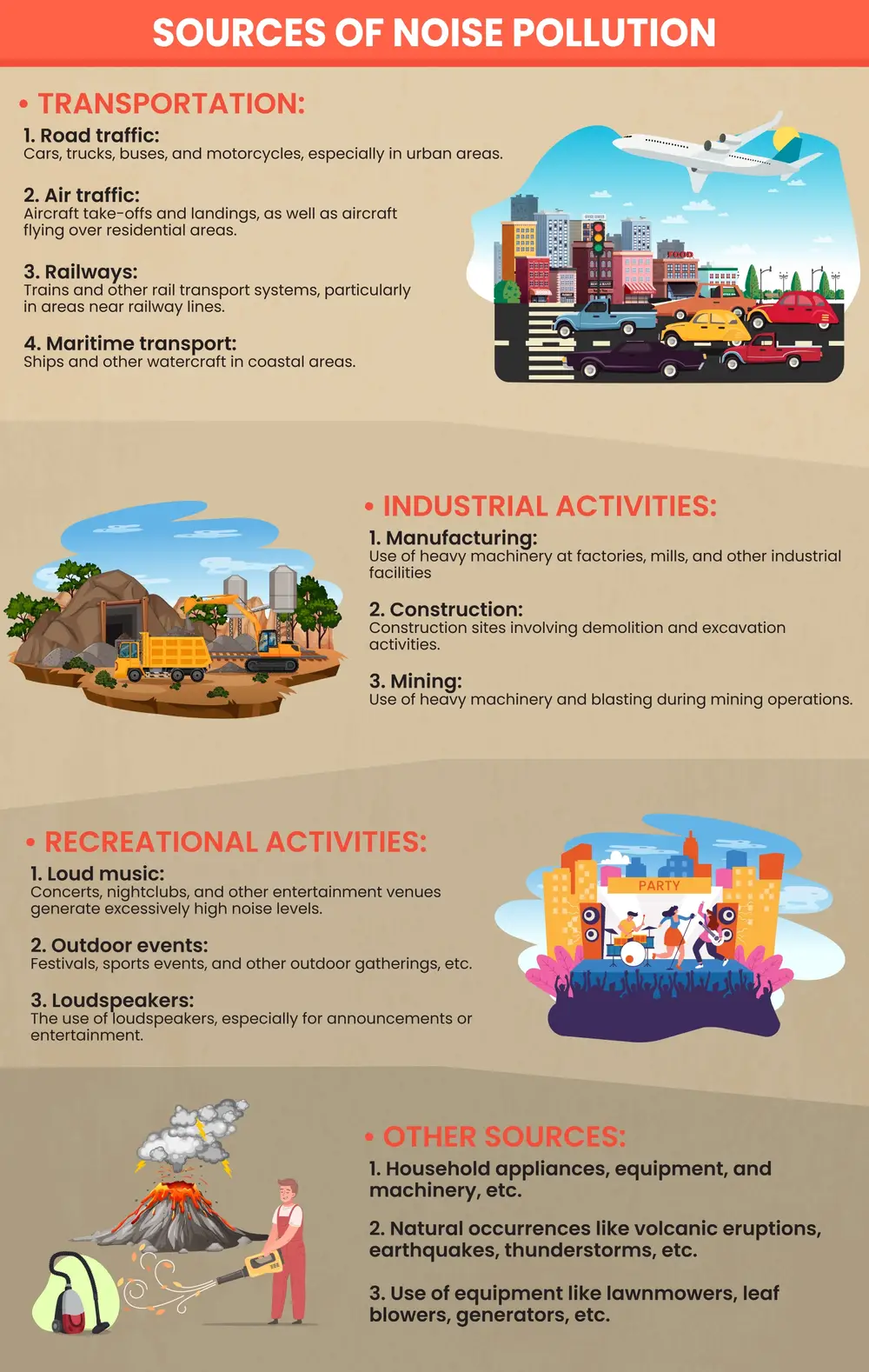Noise Pollution : The Invisible Danger - Part 1
Wed Aug 13 2025
Imagine a danger that you can't see, taste, or smell. That's noise pollution. It's often overshadowed by more visible forms of pollution, but it's a serious threat to our health and well-being. Any sound that's unwanted, disturbing, and exceeds the safe limit set by the WHO is considered noise pollution.
Sound intensity is measured in a unit called decibels (dB). There are many sounds in the environment which range from rustling leaves (20 to 30 decibels) to a thunderclap (120 decibels) to the wail of a siren (120 to 140 decibels). Sound (Noise) becomes harmful when it exceeds 75 decibels (dB) and it is painful above 120 dB".
As defined by the WHO, 'Noise above 65 decibels (dB) is noise pollution', and it's alarming to note that more than one-third of people worldwide are exposed to this pervasive issue.
Every day, millions of people are affected by noise pollution. The most common health issue of exposure to loud noise is noise-induced hearing loss (NIHL). However, noise pollution is also known to cause a range of other health issues, including heart disease, sleep disturbance, stress, headache, and memory impairment. These health issues can significantly reduce productivity and quality of life.
HOW IS NOISE INTENSITY/SEVERITY CATEGORIZED?
The noise intensity is measured in a unit called Decibels (dB). Persistent exposure to noise above 85 decibels increases the risk of hearing damage.
Let's see how this intensity of noise based on decibels is categorized.
| Sr. No. | Severity / Intensity Of Noise | Decibel (DB) Range | Examples |
| 1 | Soft | 0-40 dB | Breathing, whispering, Average room noise |
| 2 | Moderate | 40-60 dB | Normal Conversation, Average rainfall |
| 3 | Loud | 60-85 dB | Office noise, Vacuum cleaner, Lawn mover |
| 4 | Very Loud | 85-110 dB | City traffic, Railway/Subway trains, Leaf blower |
| 5 | Painful/Dangerous | 110 –140 and above | Aeroplanes, Rock concerts, Siren, Gunshot, Fireworks |

WHERE DOES NOISE POLLUTION COME FROM?
Noise is a byproduct of everyday human and natural activities. While many of these activities are normal parts of our day-to-day life, they become pollution when they exceed safe decibel levels. Here are some of the key sources:
Transportation:
- Road traffic: Vehicular traffic, consisting of cars, trucks, buses, and motorcycles, can generate a significant amount of noise, leading to pollution, especially in urban areas.
- Air traffic: Aircraft take-offs, landings, and low-flying aircraft over residential areas generate a loud noise.
- Railways: Rail transport systems, including passenger and goods trains, can be a source of noise pollution, particularly in residential areas near railway lines.
- Maritime transport: In coastal areas, Ships and other water transport, such as ferries, can significantly contribute to noise pollution.
Industrial Activities:
- Manufacturing: Heavy machinery used in factories, mills, and other industrial facilities often produces loud noises, increasing the risk of noise pollution.
- Construction: Drilling, excavation, and demolition activities, as well as instruments used at construction sites, can generate high levels of noise.
- Mining: Blasting, digging, and other mining-related operations require heavy machinery, which can also contribute to noise pollution.
Recreational Activities:
- Loud music: Concerts, clubs, and personal audio devices with high volume can generate excessive noise levels, which can be harmful.
- Outdoor events: Large outdoor public gatherings during Festivals, sports events, etc, can significantly contribute to noise pollution due to high decibel levels.
- Loudspeakers: The use of loudspeakers, especially for public announcements or for entertainment purposes, can become a source of noise pollution.
Other Sources:
- Domestic Sources: Household appliances like blenders, washing machines, vacuum cleaners, etc, can also contribute to noise pollution.
- Natural Sources: Natural occurrences like volcanic eruptions, thunderstorms, and earthquakes can generate loud noises.
- Lawn care maintenance: Lawn maintenance tools used in urban areas, like lawnmowers and leaf blowers, can create noise pollution.
- Electrical generators: Generators, especially during frequent power outages, can produce a significantly loud noise.
- Wind turbines: Surprisingly, as a renewable energy source, wind turbines can also generate noise, particularly at certain distances.

In this article, we have seen what noise pollution is, how its severity or intensity is measured and its sources. In the next part, we will examine the health hazards of noise pollution and discuss preventive and protective measures against it.
REFERENCES:-
- https://www.webmd.com/a-to-z-guides/what-is-noise-pollution
- https://education.nationalgeographic.org/resource/noise-pollution/
- https://pmc.ncbi.nlm.nih.gov/articles/PMC9832265/
- https://earth5r.org/noise-pollution-in-india-a-silent-killer/
- https://oizom.com/knowledege-bank/prevention-of-noise-impact-through-noise-monitoring/
- https://interfaithsustain.com/sources-of-noise-pollution/

